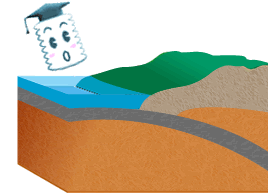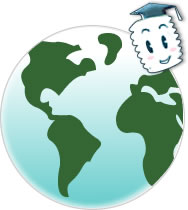
Episode 23: Earthquakes…Are they also the result of spring force?
Hello everyone.
Summer was so unbelievably hot this year! Not only in Japan. It seemed like the whole world experienced the same heat wave as in Japan.
Every year, September 1st is Disaster Prevention Day in Japan. Earthquakes, of all of the natural disasters, cause the most widespread damage.
Chile experienced a devastating earthquake in February, this year; they are still recovering from it today.
As everyone knows well, the biggest cause of earthquakes is that spring forces tend to build up underground. This build-up of force, or pressure, is caused by the movement of plates, or continents. I’d like to briefly describe the mechanisms of earthquakes to you.

The surface of the earth is composed of dozens of hard sheets, called plates that are spread out like a jigsaw puzzle around the globe. These plates move in parallel, each in their own direction, at speeds of several centimeters to several tens of centimeters through the year; most do not deform. These plates are driven by the dynamic forces of the earth’s mantle which is generated by heat convection currents.
For that reason, plates collide and are driven under each other. The result is plates affecting each other at their boundaries which forms mountain ranges, ocean trenches, and undersea mountain ranges, and causes earthquakes and volcanic activity.
There are four plates that affect Japan. The Pacific plate (facing mostly to the west), and the Philippine Sea plate (facing north-northwest) are sliding under the Eurasian plate (where the Japanese archipelago exists) and the North American plate. Interestingly, seismologists say that these four plates are joined under Shizuoka prefecture.
Most of the major earthquakes that have occurred in Japan in recent years can be classified into one of the following four types: (1) Earthquakes away from plate boundaries (Ex.: Sanriku Harukaoki Earthquake: 1994) (2) Shallow-focus earthquakes (Ex.: Hokkaido Toho-oki Earthquake: 1994) (3) Deep-focus earthquakes (Ex.: Kushiro-oki Earthquake: 1993) (4) Subduction earthquakes (Ex.: Hyogo Prefecture Nanbu Earthquake: 1995)
The fourth type of earthquake is the result of spring force. Specifically, when plates push against each other, they deform under the pressure applied from a constant direction. These types of earthquakes occur when the deformed plate attempts to return to its original shape.
The Tokai earthquake that is predicted to occur sometime in the future will be type (1), an earthquake away from the plate boundary. The location where the Philippine Sea plate is sliding under the Eurasian plate is expected to be the epicenter when that earthquake occurs. This will occur at the deepest point under the Suruga Bay, so it is also called an ocean-trench earthquake.
An earthquake with its epicenter located in the western portion of Kanagawa is predicted to occur somewhere in the region between Odawara in Kanagawa and Sagami Bay.This type of earthquake belongs to (2) above. This will cause fissures to form in the plate area at the Izu Peninsula and the plate area at Sagami Bay because the Philippine Sea plate is sliding under the North American plate.
In any case, we cannot see directly what is happening under the ground, which is unsettling.
Before an earthquake hits, mice, birds and insects move in large groups, and catfish become agitated. Could it be that they sense the changes about to occur in the earth?
It would be nice if human beings also had the capacity to detect earthquakes before they happen.

This is as far as I can go this time.
Written by Banekko (a child of spring)

